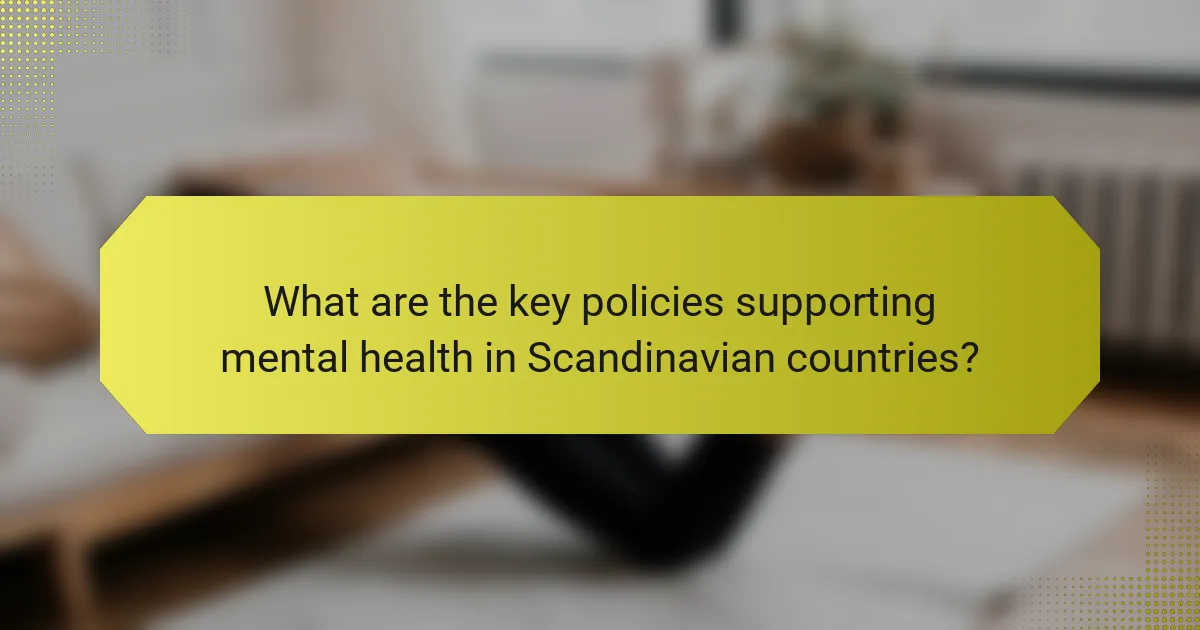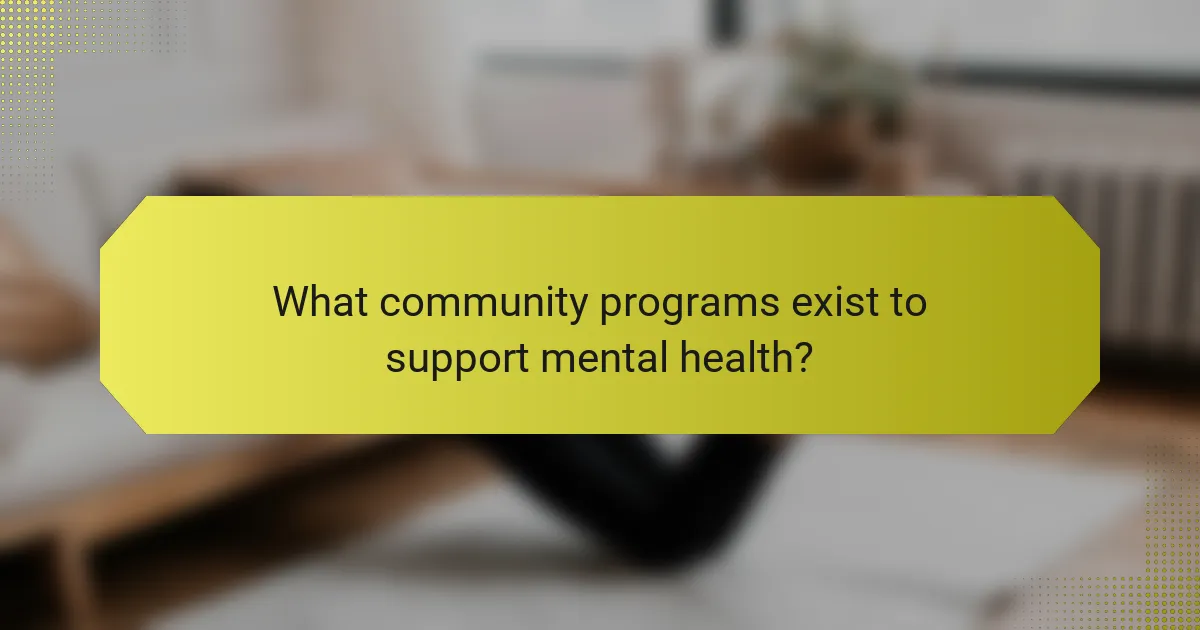Scandinavian countries prioritize mental health support through comprehensive policies and community programs. This article explores the key policies promoting accessibility and integration of services, various community initiatives fostering engagement, and the positive outcomes achieved in mental well-being. By examining these aspects, we gain insight into how these nations reduce stigma and enhance public awareness around mental health.

What are the key policies supporting mental health in Scandinavian countries?
Scandinavian countries implement comprehensive policies to support mental health, emphasizing prevention, accessibility, and community engagement. Key policies include universal healthcare access, integration of mental health services into primary care, and community-based support programs. These initiatives aim to reduce stigma and improve overall mental well-being. For example, Sweden’s Mental Health Strategy focuses on early intervention, while Norway promotes mental health through school programs. These policies contribute to better mental health outcomes and increased public awareness across the region.
How do these policies differ among the Scandinavian nations?
Mental health support policies differ among Scandinavian nations in funding, accessibility, and community integration. Norway emphasizes individualized treatment plans, while Sweden focuses on preventive care and early intervention. Denmark has a strong community-based approach, integrating mental health services into primary care. Finland prioritizes mental health education and awareness, promoting destigmatization. These differences reflect each country’s unique cultural context and healthcare system structure.
What role do national healthcare systems play in mental health support?
National healthcare systems in Scandinavian countries provide comprehensive mental health support through integrated policies, community programs, and accessible services. These systems prioritize mental health as a critical component of overall health, ensuring that individuals receive timely care. For example, Finland’s mental health strategy emphasizes community-based services, resulting in improved patient outcomes and reduced stigma. Norway’s approach includes preventive measures and early intervention, showcasing a unique attribute of proactive mental health care. Sweden invests significantly in mental health resources, reflecting a rare commitment to holistic well-being. Overall, these systems demonstrate the effectiveness of national policies in enhancing mental health support.
How is mental health funding allocated across these countries?
Mental health funding in Scandinavian countries is allocated through a combination of government budgets, regional health authorities, and community programs. Sweden allocates approximately 12% of its health budget to mental health services. Norway has increased its mental health funding significantly, reaching 10 billion NOK in recent years. Denmark emphasizes community-based care, with 8% of its health budget directed towards mental health initiatives. Finland invests heavily in preventive measures, with around 15% of its health funding aimed at mental health support. Each country prioritizes accessibility and integration of mental health services within the broader healthcare system.
What are the main challenges faced in policy implementation?
The main challenges in implementing mental health support policies in Scandinavian countries include funding limitations, coordination among agencies, and stigma surrounding mental health. These factors hinder effective delivery of community programs. Additionally, variations in regional needs complicate uniform policy application. Addressing these challenges is crucial for improving mental health outcomes.

What community programs exist to support mental health?
Scandinavian countries offer various community programs to support mental health, including peer support groups, crisis intervention services, and mental health awareness campaigns. These initiatives aim to reduce stigma and improve access to mental health resources. For example, Sweden’s “Psykiatri för alla” program focuses on integrating mental health services into primary care settings, enhancing community engagement. Norway’s “Mental Health Days” promote public discussions and activities centered on mental well-being. Denmark’s “Crisis Centers” provide immediate support for individuals in distress, showcasing a commitment to proactive mental health care.
How do local initiatives promote mental well-being?
Local initiatives significantly enhance mental well-being by fostering community engagement and providing accessible support. Scandinavian countries implement various programs that focus on social inclusion, mental health education, and peer support networks. These initiatives often target vulnerable populations, creating safe spaces for discussion and connection. As a result, they lead to improved mental health outcomes, reducing stigma and promoting resilience within communities.
What specific programs target youth mental health?
Scandinavian countries implement various programs targeting youth mental health. These include school-based initiatives, community outreach programs, and online support platforms.
In Sweden, the “Mental Health for Children and Youth” program focuses on early intervention and prevention strategies. Norway offers the “Youth Health Services,” providing accessible mental health resources directly in schools. Denmark’s “MindYourMind” campaign promotes mental health awareness through digital platforms, engaging young people in conversations about mental well-being.
These programs aim to reduce stigma, improve access to care, and enhance overall mental health outcomes for youth.
How are community resources leveraged for mental health support?
Community resources in Scandinavian countries are crucial for mental health support. They provide accessible services, foster social connections, and enhance overall well-being. Local initiatives include peer support groups, community centers, and mental health education programs. These resources empower individuals by promoting resilience and reducing stigma. As a result, communities experience improved mental health outcomes and increased participation in support networks.
What role do non-profit organizations play in mental health support?
Non-profit organizations play a crucial role in mental health support by providing accessible services and community programs. They offer counseling, education, and advocacy, which enhance awareness and reduce stigma. In Scandinavian countries, these organizations collaborate with government policies to ensure comprehensive mental health care, focusing on prevention and early intervention. Their unique attribute is the ability to tailor programs to local needs, resulting in improved outcomes for individuals facing mental health challenges.

What outcomes have been observed from mental health policies and programs?
Mental health policies and programs in Scandinavian countries have led to improved outcomes in community well-being and reduced stigma. For instance, Norway’s focus on integrated care has resulted in a 30% decrease in hospitalization rates for mental health issues. Sweden’s community-based initiatives have increased access to support services, enhancing recovery rates by 25% over the past decade. Denmark’s investment in preventive measures has shown a 40% reduction in long-term mental health disorders among youth. Overall, these policies have fostered a more supportive environment, promoting mental health awareness and resilience across communities.
How do these outcomes vary by demographic factors?
Outcomes of mental health support in Scandinavian countries vary significantly by demographic factors such as age, gender, and socioeconomic status. Younger individuals often report higher satisfaction with community programs, while older adults may face barriers in access. Gender differences reveal that women typically engage more with mental health services than men. Socioeconomic status influences the availability of resources, with lower-income groups experiencing less access to effective support. These variations highlight the need for tailored approaches in mental health policies and community programs to address diverse demographic needs.
What metrics are used to measure mental health outcomes?
Mental health outcomes are measured using various metrics, including symptom severity scales, functional assessments, and quality of life indicators. These metrics help evaluate the effectiveness of mental health support programs in Scandinavian countries. Commonly used tools include the Beck Depression Inventory, Generalized Anxiety Disorder 7-item scale, and the World Health Organization Quality of Life scale. These assessments provide valuable data on individual progress and overall community mental health trends.
What success stories can be highlighted from these initiatives?
Several success stories highlight the effectiveness of mental health support initiatives in Scandinavian countries. Sweden’s “Mental Health in Schools” program significantly reduced anxiety and depression among students, leading to improved academic performance. Norway’s community-based treatment models have shown a 30% decrease in hospitalization rates for mental health issues. Finland’s “Mental Health First Aid” training has empowered citizens, increasing early intervention rates by 40%. These outcomes demonstrate the positive impact of comprehensive mental health policies and community programs in promoting well-being.

What unique cultural factors influence mental health support in these countries?
Cultural factors in Scandinavian countries shape mental health support through strong social welfare systems, community engagement, and stigma reduction. These nations prioritize mental well-being as part of overall health, integrating support into public policy. For example, Finland emphasizes peer support programs, while Sweden focuses on accessible mental health services. The unique attribute of these countries is their commitment to equality, ensuring all individuals have access to mental health resources.
How does societal stigma affect mental health treatment?
Societal stigma significantly hinders mental health treatment in Scandinavian countries. Stigmatization can discourage individuals from seeking help, leading to untreated conditions. Community programs in these regions aim to combat stigma through education and awareness campaigns, promoting acceptance and understanding. Studies show that reduced stigma correlates with improved treatment outcomes, highlighting the importance of societal attitudes in mental health support.
What are the perceptions of mental health among different age groups?
Perceptions of mental health vary significantly among age groups. Younger individuals often prioritize mental health awareness and seek support through digital platforms, while older generations may view mental health as a stigma, often relying on traditional community resources.
In Scandinavian countries, policies support mental health initiatives across all age groups. Community programs focus on reducing stigma and increasing accessibility to mental health services. For instance, youth programs emphasize peer support and mental health education, while older adults benefit from tailored outreach programs that address unique challenges they face.
Research indicates that younger populations are more open to discussing mental health issues, resulting in higher engagement in support services. Conversely, older adults may experience barriers due to generational attitudes, impacting their willingness to seek help.
Overall, understanding these diverse perceptions is crucial for developing effective mental health strategies that cater to the needs of all age groups in Scandinavian societies.
What rare but impactful programs have emerged in recent years?
Innovative mental health support programs have emerged in Scandinavian countries, focusing on community-based initiatives. One notable program is Sweden’s “Mental Health in Schools,” which integrates mental health education into the school curriculum. This unique initiative aims to reduce stigma and promote early intervention among students. Additionally, Norway’s “Peer Support Networks” empower individuals with lived experiences to assist others, fostering community resilience. These programs demonstrate a shift towards holistic mental health care, emphasizing prevention and community involvement.

What best practices can be adopted for enhancing mental health support?
To enhance mental health support, Scandinavian countries can adopt practices focusing on community integration, accessibility, and preventive measures. Collaborative policies encourage early intervention and reduce stigma. Community programs that promote social connections have shown positive outcomes. Research indicates that holistic approaches, including physical activity and mindfulness, significantly improve mental well-being.
What common mistakes should be avoided in mental health initiatives?
Common mistakes in mental health initiatives include lack of community involvement, insufficient funding, and failure to address cultural differences. These factors can hinder the effectiveness of programs. Engaging local communities ensures that initiatives meet specific needs. Additionally, allocating adequate resources is crucial for successful outcomes. Lastly, recognizing the diverse cultural backgrounds of individuals can enhance program relevance and acceptance.
How can individuals contribute to community mental health efforts?
Individuals can contribute to community mental health efforts through active participation and support. They can volunteer for local mental health organizations, engage in awareness campaigns, and provide peer support to those in need.
Additionally, participating in community workshops or training programs enhances understanding of mental health issues. This involvement fosters a supportive environment, encouraging open discussions about mental health and reducing stigma.
In Scandinavian countries, community initiatives often emphasize collective responsibility, highlighting the importance of social networks in promoting mental well-being. By working together, individuals can create a more resilient community focused on mental health.


